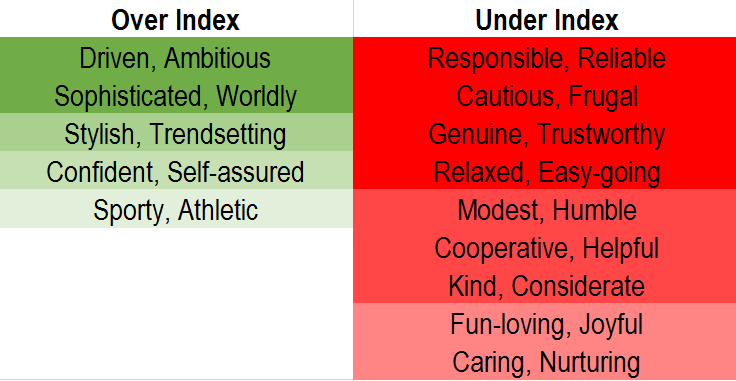It’s about a 5 min. read.

The kind of car you drive says a lot about who you are—at least according to other peoples’ perceptions. And the more people identify with that perception, the more likely they are to use that brand, or in this case, drive that car.
This is important for marketers responsible for effectively communicating their brand to the target market. How is their typical customer perceived? Does that customer image align with their brand?
I’m not much of a joiner so I never thought much about what my car says about me. That is, until I joined a new tribe of car owners.
When I was recently debating buying a new car, my colleague said she wouldn’t speak to me again if I bought this certain brand. I did anyway. Even though she might be unhappy that I now drive this particular car, she still speaks to me (must need some analysis done).
In a self-funded study, we found the typical owner of this brand is viewed as: wealthy, confident, fun, stuck up, young, snobby, arrogant, and cool, among others. In reading this description, you can probably tell it’s not a Buick.
But this brand’s marketing team might have a strong interest to figure out how best to play up the positive characteristics (cool) and play down or negate the negative dimensions (arrogant/stuck up). My kids still don’t think I’m cool.

Why does this brand generate such a view? It over-indexes on dimensions that might not seem approachable (i.e., worldly, trendsetting) and under-indexes on dimensions that might resonate with a wider audience (i.e., responsible, genuine, relaxed). This perception reflects a very specific view of the typical driver and risks alienating a potentially huge customer base.
Maybe that’s okay if you’re a niche product with a narrow target market, but then again, maybe not.

What does it all mean? Interestingly enough, I’ve seen a change in the way my fellow motorists treat me on the road. Take that with a grain of salt as we typically refer to drivers around here as MASSH@^%$ (editor made me type that despite my STET comment on the first draft).
In my previous domestic brand car, when I put my turn signal on, folks tended to let me change lanes. Now, they race up to box me out. At red lights, other drivers want to race. While my car does have some serious horse power, I don’t drive it that way. I guess if folks don’t see me as kind and caring based on the car I drive, why should I expect them to be kind and caring to me on the road?
Marketers beyond the car industry should be thinking about this, too. How are you communicating who your brand’s typical customer is? Is that image relatable? Is it desirable? Your messaging should clearly and effectively communicate who your customer is in the best light—whatever that means for your brand.